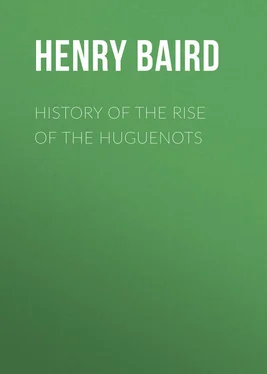Henry Baird - History of the Rise of the Huguenots
Здесь есть возможность читать онлайн «Henry Baird - History of the Rise of the Huguenots» — ознакомительный отрывок электронной книги совершенно бесплатно, а после прочтения отрывка купить полную версию. В некоторых случаях можно слушать аудио, скачать через торрент в формате fb2 и присутствует краткое содержание. ISBN: , Жанр: foreign_antique, foreign_prose, на английском языке. Описание произведения, (предисловие) а так же отзывы посетителей доступны на портале библиотеки ЛибКат.
- Название:History of the Rise of the Huguenots
- Автор:
- Жанр:
- Год:неизвестен
- ISBN:http://www.gutenberg.org/ebooks/30708
- Рейтинг книги:4 / 5. Голосов: 1
-
Избранное:Добавить в избранное
- Отзывы:
-
Ваша оценка:
- 80
- 1
- 2
- 3
- 4
- 5
History of the Rise of the Huguenots: краткое содержание, описание и аннотация
Предлагаем к чтению аннотацию, описание, краткое содержание или предисловие (зависит от того, что написал сам автор книги «History of the Rise of the Huguenots»). Если вы не нашли необходимую информацию о книге — напишите в комментариях, мы постараемся отыскать её.
History of the Rise of the Huguenots — читать онлайн ознакомительный отрывок
Ниже представлен текст книги, разбитый по страницам. Система сохранения места последней прочитанной страницы, позволяет с удобством читать онлайн бесплатно книгу «History of the Rise of the Huguenots», без необходимости каждый раз заново искать на чём Вы остановились. Поставьте закладку, и сможете в любой момент перейти на страницу, на которой закончили чтение.
Интервал:
Закладка:
It bursts out at Caen.
We have an illustration of the way in which the work of demolition was accomplished in events occurring about this time at Caen. Two or three inhabitants of this old Norman city were at Rouen when the churches were invaded and sacked by an over-zealous crowd of sympathizers with the "new doctrines." On their return to their native city, they began at once to urge their friends to copy the example of the provincial capital. The news reaching the ears of the magistrates of Caen, these endeavored – but to no purpose, as the sequel proved – to calm the feverish pulse of the people. On a Friday night (May eighth), the storm broke out, and it raged the whole of the next day. Church, chapel, and monastery could testify to its violence. Quaint windows of stained glass and rich old organs were dashed in pieces. Saints' effigies, to employ the quaint expression of a Roman Catholic eye-witness, "were massacred." "So great was the damage inflicted, without any profit, that the loss was estimated at more than a hundred thousand crowns." Still less excusable were the acts of vandalism which the rabble – ever ready to join in popular commotions and always throwing disgrace upon them – indulged. The beautiful tombs of William, Duke of Normandy and conqueror of England, and of the Duchess-queen Mathilda, the pride of Caen, which had withstood the ravages of nearly five hundred years, were ruthlessly destroyed. The monument of Bishop Charles of Martigny, who had been ambassador under Charles the Eighth and Louis the Twelfth, shared the same fate. The zealous Roman Catholic who relates these occurrences claims to have striven, although to no purpose, to rescue the ashes of the conqueror from dispersion. 88 88 Les Recherches et Antiquitez de la ville de Caen, par Charles de Bourgueville, sieur du lieu, de Bras, et de Brucourt. À Caen, 1588. Pt. ii. 170-172. From page 76 onward the author gives us a record of notable events in his own lifetime. So also at Cléry, it is to be regretted that, not content with greatly injuring the famous church of Our Lady, the Huguenot populace, inflamed by the indiscretion of the priests, desecrated the monuments of the brave Dunois, and of Louis the Eleventh and his queen. Hist. ecclés. des égl. réf., ii. 23. According to the author of the "Horribles cruautés des Huguenots en France" (Cimber et Danjou, vi. 304), they even burned the bones of Louis; nor did they respect those of the ancestors of the Prince of Condé.
The "idol" of Sainte Croix.
The contagion spread even to Orleans. Here, as in other places where the Huguenots had prevailed, there were but few of the inhabitants that had not been drawn over to the reformed faith, or at least pretended to embrace it. Yet Condé, in his desire to convince the world that no partisan hatred moved him, strictly prohibited the intrusion of Protestants into the churches, and assured the ecclesiastics of protection so long as they chose to remain in the city. For a time, consequently, their services continued to be celebrated in the presence of the faithful few and with closed doors; but soon, their fears getting the better of their prudence, the priests and monks one by one made their retreat from the Protestant capital. On the twenty-first of April, word was brought to Condé that some of the churches had been broken into during the preceding night, and that the work of destruction was at that very moment going forward in others. Hastening, in company with Coligny and other leaders, to the spacious and imposing church of the Holy Rood (Sainte Croix), he undertook, with blows and menaces, to check the furious onslaught. Seeing a Huguenot soldier who had climbed aloft, and was preparing to hurl from its elevated niche one of the saints that graced the wall of the church, the prince, in the first ebullition of his anger, snatched an arquebuse from the hands of one of his followers, and aimed it at the adventurous iconoclast. The latter had seen the act, but was in no wise daunted. Not desisting an instant from his pious enterprise, "Sir," he cried to Condé, "have patience until I shall have overthrown this idol; and then let me die, if that be your pleasure!" 89 89 "Monsieur, ayez patience que j'aie abattu cette idole, et puis que je meure, s'il vous plaît."
The Huguenot soldier's fearless reply sounded the knell of many a sacred painting and statue; for the destruction was accepted as God's work rather than man's. 90 90 "Comme étant ce fait plutôt œuvre de Dieu que des hommes." Hist. ecclés. des égl. réf., ii. 20. "L'impétuosité des peuples était telle contre les images, qu'il n'était possible aux hommes d'y résister." Ibid. ii. 23.
Henceforth little exertion was made to save these objects of mistaken devotion, while the greatest care was taken to prevent the robbery of the costly reliquaries and other precious possessions of the churches, of which inventories were drawn up, and which were used only at the last extremity. 91 91 Hist. ecclés. des égl. réf., ii. 20-22.
Massacre of Huguenots at Sens.
Far different in character from the bloodless "massacres" of images and pictures in cities where the Huguenots gained the upper hand, were the massacres of living men wherever the papists retained their superiority. One of the most cruel and inexcusable was that which happened at Sens – a city sixty-five or seventy miles toward the south-east from Paris – where, on an ill-founded and malicious rumor that the reformed contemplated rising and destroying their Roman Catholic neighbors, the latter, at the instigation, it is said, of their archbishop, the Cardinal of Guise, and encouraged by the violent example of Constable Montmorency at Paris, 92 92 "Ledict moys," says Jehan de la Fosse in his journal (p. 47), "des citoyens de Sens tuèrent beaucoup de huguenots, voyant que monsieur le connétable avoict faict brûler Popincourt."
fell on the Protestants, murdered more than a hundred of both sexes and of every age, and threw their dead bodies into the waters of the Yonne. 93 93 Hist. ecclés. des égl. réf., ii. 242-245; Jean de Serres, ii. 40; De Thou, iii. 144. The massacre commenced on Sunday, April 12th (not 14th, as the Hist. ecclés. states), and was continued the next day or two. According to De Serres, the horrors of Sens seemed to efface those of Vassy itself. Read the really terrible paragraph on the subject in the contemporary "Remonstrance au Roy sur le faict des Idoles abbatues et déjettées hors des Temples" (Mém. de Condé, iii. 355-364), beginning "Où sont les meurtres, les boucheries des hommes passés au fil de l'espée, par l'espace de neuf jours en la ville de Sens?" The address to the Cardinal of Guise is not less severe than the address to his brother in the famous " Tigre ": "Te suffisoit-il pas, Cardinal, que le monde sceust que tu es Atheiste, Magicien, Nécromantien, sans le publier davantage, et faire ouvrir en pleine rue les femmes grosses pour voir le siége de leurs enfans?" P. 360. White (Mass. of St. Bartholomew, 200) confounds in his account the two brother cardinals, and makes Lorraine to have been Archbishop of Sens.
While these victims of a blind bigotry were floating on under the windows of the Louvre toward the sea, Condé addressed to the queen mother a letter of warm remonstrance, and called upon her to avenge the causeless murder of so many innocent men and women; expressing the fear that, if justice were denied by the king and by herself, the cry of innocent blood would reach high heaven, and God would be moved to inflict those calamities with which the unhappy realm was every day threatened. 94 94 Letter of Condé of April 19th, Mém. de Condé, iii. 300, 301; Hist. ecclés. des égl. réf., ii. 246, 247; J. de Serres, ii. 40-42.
Интервал:
Закладка:
Похожие книги на «History of the Rise of the Huguenots»
Представляем Вашему вниманию похожие книги на «History of the Rise of the Huguenots» списком для выбора. Мы отобрали схожую по названию и смыслу литературу в надежде предоставить читателям больше вариантов отыскать новые, интересные, ещё непрочитанные произведения.
Обсуждение, отзывы о книге «History of the Rise of the Huguenots» и просто собственные мнения читателей. Оставьте ваши комментарии, напишите, что Вы думаете о произведении, его смысле или главных героях. Укажите что конкретно понравилось, а что нет, и почему Вы так считаете.












